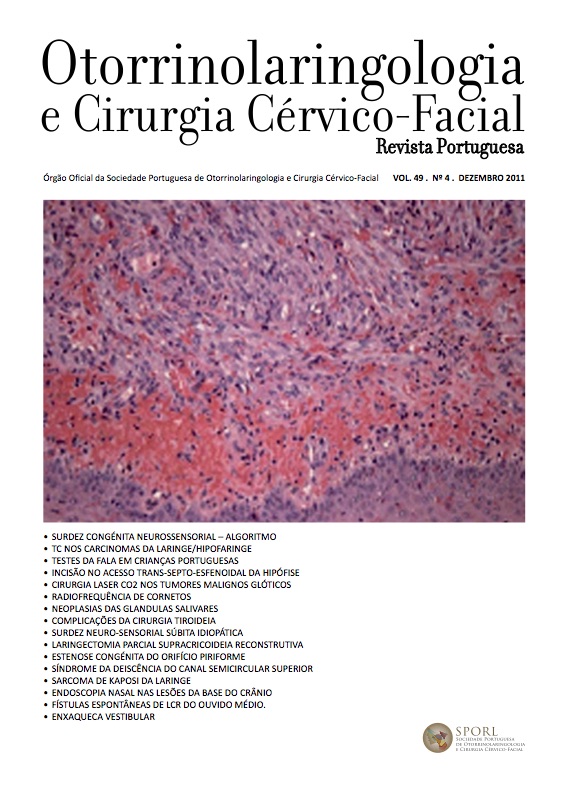Complications of thyroid surgery: Control and treatment
DOI:
https://doi.org/10.34631/sporl.196Keywords:
Thyroid surgery, recurrent laryngeal nerve, papillary microcarcinoma, hypocalcemiaAbstract
Introduction and goals: Thyroid nodules occur in 4% of the population. The most common indication for thyroid surgery is a multinodular goiter, increasing in areas with iodine deficiency. The diagnosis of thyroid carcinoma in patients operated on for multinodular goiter is between 7-14%.Thyroid cancer is the most common malignant glandular tumor.
Methods: We performed a retrospective study on patients operated of thyroid pathology from 2007 to 2009 .We identified epidemiological data, surgical indication and complications of the surgery glandular as hypocalcemia or recurrent palsy.
Results: A total of 139 patients were studied. The most common indications for surgery were thyroid nodule (43.88%) and multinodular goiter (38.84%). There was a 28% discrepancy between pre/postoperative results on pathological anatomy. In all these cases, preoperative FNAC (fine-needle aspiration cytology) had a result of colloid goiter, in contrast to the histopathology of the surgical specimen, in which localized foci of papillary microcarcinoma were found. After surgery 27% of patients had temporary hypocalcemia. Two cases of 139 patients showed permanent recurrent palsy. Intrathoracic goiter was identified in 15.82% of patients.
Discussion and Conclusions: There must be a daily monitoring of postoperative calcium levels. We recommend treatment with calcium (oral and intravenous) if lower levels of 7.2mg/ dl or less than 8mg/dl but in patients with signs / clinical hypocalcemia. Recurrent permanent palsy were in patients operated on papillary carcinoma. The surgical approach in the case of intrathoracic goiter was cervical access without requiring sternotomy. Thyroid surgery is not without complications and permanent damage such as recurrent palsy or hypocalcemia. The experience of the otolaryngologist in cervical surgery have a key role in reducing of the complications. Indications should be performed protocols with other services such as Endocrinology.
Downloads
References
Marco A. Soto Bigot .Evaluación diagnóstica de nódulo tiroideo (revisión bibliográfica). Revista médica de Costa Rica y Centroamerica LXV 2008; 586: 371-375
Giles Y, Boztepe H, Terziglu T, Tezelman S. The advantage of total thyroidectomy to avoid reoperation for incidental thyroid cáncer in multinodular goiter. Arch Surg. 2004;139: 179-182
Gandolfi PP, Frisina A, Raffa M, Renda F, Rocchetti O, Ruggeri C, Tombolini A. The incidence of Thyroid Carcinoma in Multinodular
Goiter: Retrospective Analysis. Acta Bio Medica Ateneo Parmense. 2004;75: 114-117
Torres J, Volpato RD, Power EG, López EC, Dominguez ME, et al. Thyroid Cancer. Survival in 148 cases followed for 10 years or more. Cáncer 1985; 56: 2298-2304
Acevedo García F. Hipertiroidismo..Revista de la SEMG. 2004;69:622-625 E
Arias Mendez M. Bocio multinodular con extensión intratorácica . Reporte de caso clínico. Revista Médica de Costa Rica y Centroamérica. 2004; 566: 46-46
Ríos A, Rodríguez-González JM, Balsalobre MD, Soria T, Canteras M, Parrilla P. Resultados del tratamiento quirúrgico en 247 pacientes con bocio multinodular con componente intratorácico. Cir Esp. 2004; 75(3):140-5
Hernán D, González, Mosso L. Cáncer papilar de tiroides: Visión actual. Boletín de la Escuela de Medicina 2006; 31(2): 87-91
Corrales Hernández JJ, Martín Iglesias D, Gómez Alonso FJ. Microcarcinoma papilar de tiroides.¿ Es necesario el tratamiento
con I131 tras la cirugía? Argumentos a favor. Endocrinología y nutrición.2006;53(6): 390-8
Tezelman S, Borucu I, Senyurek Y, Tunca F, Terzioglu T. The Change in surgical practice from subtotal to near total or total thyroidectomy in the treatment of patients with benign multinodular goiter. World Journal of Surgery. 2009; 33: 400-405
Gac P , Cabané , Amat J , Huidobro F, Rossi R , Rodríguez F, Ferrada C, Cardemil F . Incidence of hypocalcemia after total thyroidectomy. Rev Méd Chile .2007; 135: 26-30
Acun Z, Cinar F, Cihan A, Can Ulukent S, Uzun L, Ucan B, B.Ugur M. Importance of identify the course of the recurrent laryngeal nerve in total and near total thyroid lobectomies. The American Surgeon. 2005; 71: 225-227
Dralle H, Sekulla C, Lorenz K, Brauckhoff M, Machens A. Intraoperative Monitoring of the recurrent laryngeal nerve in thyroid
surgery. World Journal of Surgery .2008; 32: 1358-1366
Meyer T , Hamelmann W ,Timmermann W, Meyer B, Hocht B. The advantages and disadvantages of nerve monitoring during thyroid surgery in Childhood. Eur J Pediatric Surg. 2006; 16: 392-395






